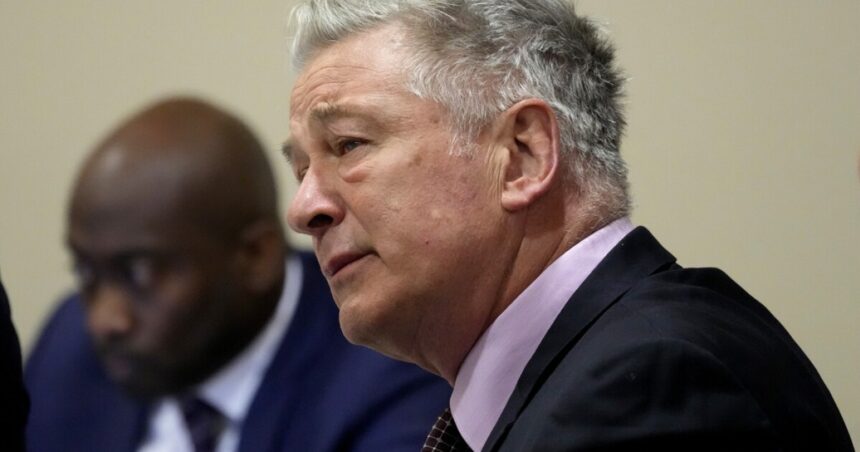A defense attorney addressed the jurors on Wednesday, describing the shooting death of cinematographer Halyna Hutchins as an “unspeakable tragedy.” However, he emphasized that Alec Baldwin did not commit a crime because he was simply acting as an actor.
Baldwin’s lawyer, Alex Spiro, emphasized during his opening statement in a Santa Fe, New Mexico, courtroom that Baldwin, who is facing trial for involuntary manslaughter, was following the standard procedures actors typically follow on the set of the film “Rust,” where the incident occurred in October 2021.
“I don’t need to elaborate further on this, as you’ve all seen gunfights in movies,” Spiro stated.
Special prosecutor Erlinda Ocampo Johnson, in her opening statement, alleged that Baldwin neglected safety protocols and handled a revolver recklessly before the shooting took place.
“The evidence will demonstrate that the individual who mishandled a real gun and disregarded firearm safety rules is the defendant, Alexander Baldwin,” Ocampo Johnson asserted.
Spiro countered by stating that “these safety rules do not apply in the same way on a movie set.”
“On a film set, safety precautions must be taken before placing a gun in an actor’s hand,” Spiro informed the jury.
The first witness to testify was the initial law enforcement officer who arrived at the scene at Bonanza Creek Ranch after the shooting. The courtroom was shown video footage from the body camera of Nicholas LeFleur, a former Santa Fe county sheriff’s deputy, displaying efforts to assist Hutchins, who appeared unconscious as individuals provided aid and administered oxygen. Baldwin, watching the footage in court, appeared solemn.
Following the video, LeFleur can be seen instructing Baldwin not to communicate with other potential witnesses, which Baldwin repeatedly disregarded.
When asked if he handled the situation optimally, the deputy admitted, “Probably not. But it’s what happened.”
RELATED STORY | Judge decides Alec Baldwin’s role as co-producer not relevant to trial over fatal 2021 set shooting
Spiro attempted to demonstrate that neither LeFleur nor the trial’s second witness, former sheriff’s Lt. Tim Benavidez, treated the scene as a significant crime scene. Benavidez, who retrieved the revolver post-shooting, acknowledged handling it cautiously for safety rather than conducting a meticulous forensic examination typical of a homicide investigation.
Ocampo Johnson, in her opening statement, described the events leading up to Hutchins’ death and accused Baldwin of disregarding safety protocols with armorer Hannah Gutierrez-Reed before the fatal incident in a church near the courthouse where Hutchins was killed. She alleged that Baldwin acted independently.
“He cocked the hammer, aimed it at Miss Hutchins, and fired, resulting in the live round hitting Miss Hutchins,” Ocampo Johnson stated.
During the proceedings, Baldwin focused on a notepad, avoiding eye contact with the jury. His wife, brother, and sister were present in support.
The jurors, largely from a region with a strong gun culture, were informed about the tragic incident that led to the charges against Baldwin.
The death of Hutchins and injury of director Joel Souza shocked the film industry and resulted in a felony charge against Baldwin, which could lead to a prison term of up to 18 months.
“It took the life of an incredible individual, wounded another, and forever altered lives,” Spiro remarked.
Baldwin claimed the gun discharged accidentally while following instructions to aim it toward Hutchins, stating he was unaware of the live round, and it fired when he pulled back the hammer, not the trigger.
“No one witnessed him intentionally pulling the trigger,” Spiro emphasized.
Even if Baldwin had pulled the trigger, Spiro argued it still would not constitute manslaughter.
“On a film set, actors are permitted to pull the trigger,” Spiro clarified, adding that it does not equate to homicide.
RELATED STORY | New Mexico judge weighs whether to compel testimony from ‘Rust’ movie armorer in Alec Baldwin trial
The responsibility for safety, according to Spiro, lies with the film’s armorer, Gutierrez-Reed, who was convicted of involuntary manslaughter, and assistant director David Halls, who pleaded no contest to negligent weapon use in exchange for his testimony.
Before handling the revolver, Baldwin was informed it was a “cold gun” and was unaware of the live round inside.
“Those responsible for ensuring the gun’s safety had checked and rechecked it. Baldwin did not tamper with it, load it, or leave it unattended,” Spiro emphasized.
Spiro is known for representing high-profile clients and concluded by mentioning that witnesses would confirm that no actor has ever intercepted a live bullet from a prop gun.
“No one could have predicted or expected an actor to do that,” Spiro stated.
Further testimony will examine the firearm’s mechanics and whether it could discharge without a trigger pull, a claim disputed by the prosecution.
Attorney Gloria Allred, representing individuals in a civil lawsuit related to the incident, was present in the courtroom audience.
Allred observed that the jury appeared captivated by the testimony and evidence presented, including the footage from the police lapel camera.





